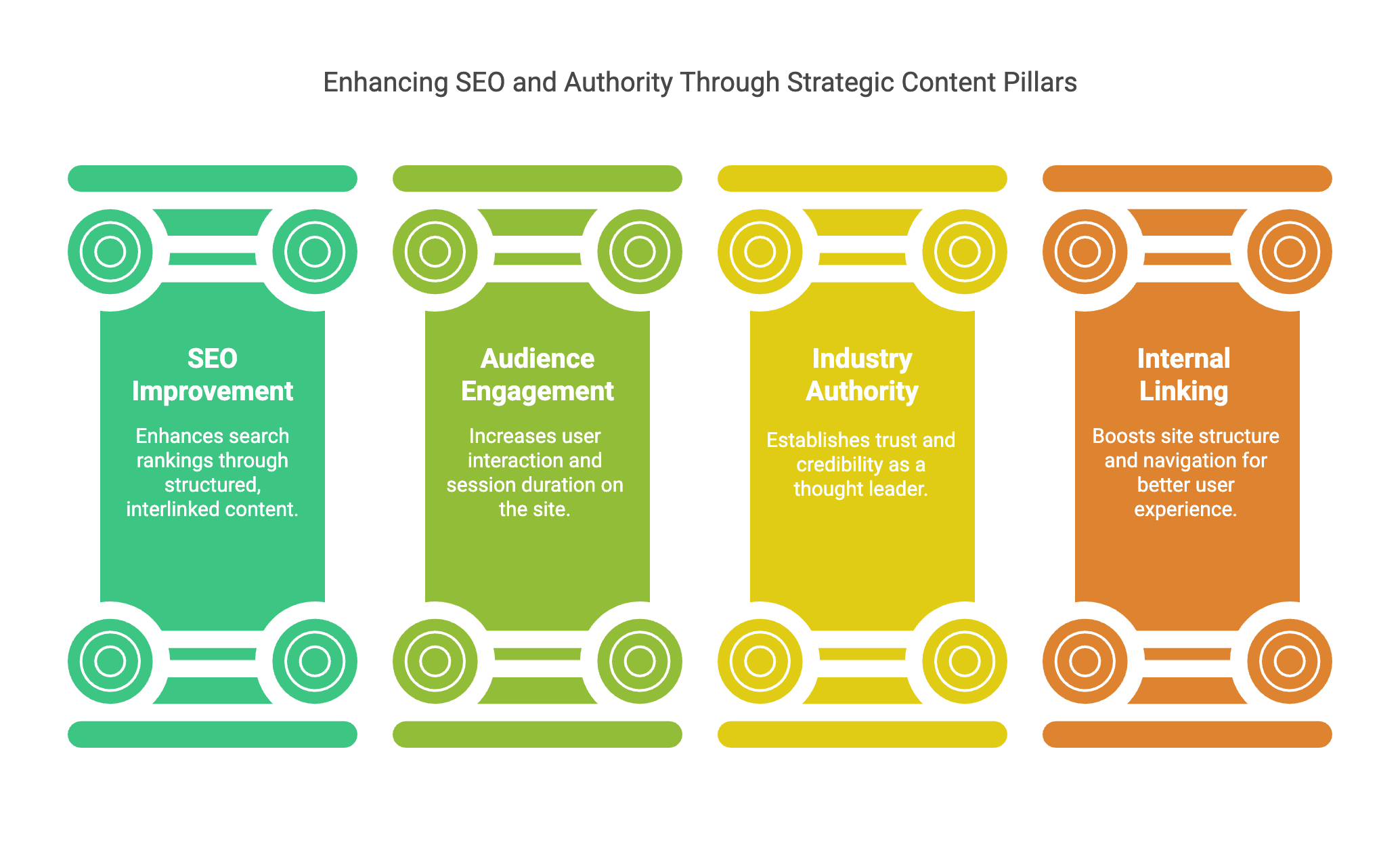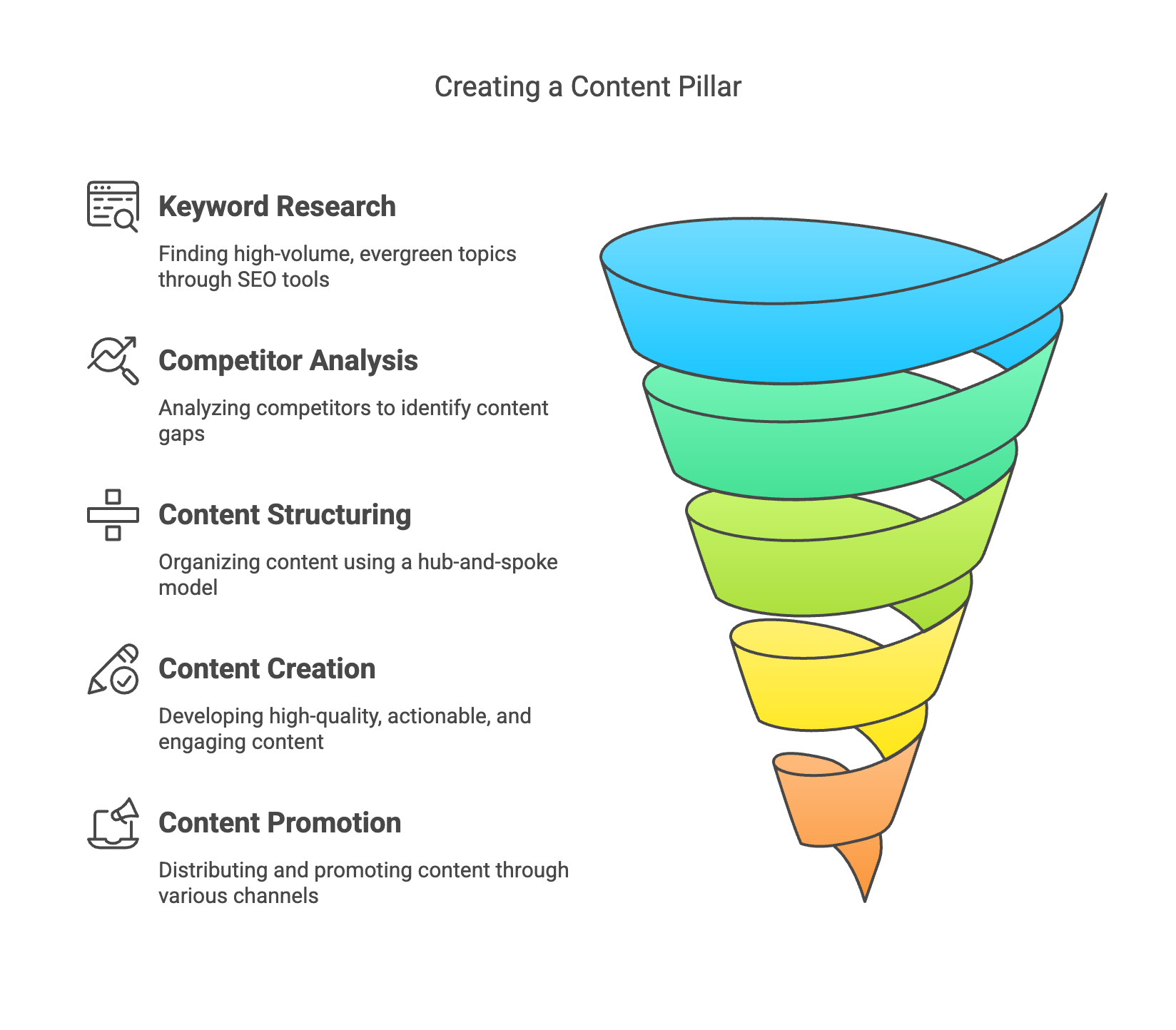Content is the foundation of digital marketing, but not all content is created equal. If you’ve ever struggled with scattered blog posts that don’t drive traffic or convert readers into customers, it’s time to rethink your strategy. The answer? Content pillars.
A content pillar is a comprehensive, in-depth piece of content that serves as the foundation for multiple subtopics. It provides structure to your content strategy, enhances SEO, and positions you as an authority in your industry. In this article, we’ll explore how to create a content pillar strategy that boosts rankings, engages readers, and keeps them coming back for more.
What Are Content Pillars?
A content pillar is a long-form, authoritative resource that covers a core topic in-depth. It is designed to be the central hub for related subtopics, which are covered in supporting content like blog posts, videos, and infographics.
There are three main types of content pillars:
- The “Ultimate Guide” Pillar – A deep-dive educational resource on a specific topic (e.g., “The Ultimate Guide to SEO Optimization”).
- The “Topic Cluster” Pillar – A hub-and-spoke model where one central page links to various subtopics (e.g., “Content Marketing Strategies” linking to posts on social media, blogging, and video marketing).
- The “Resource Hub” Pillar – A curated list of tools, studies, or insights for a niche (e.g., “Best AI Tools for Content Creation”).
Regardless of which type you choose, the goal remains the same: provide immense value while structuring content in a way that search engines and users love.

Why Content Pillars Matter for SEO and Authority
Content pillars play a crucial role in search engine optimization (SEO) and in establishing brand authority. When structured correctly, they create a well-organized content ecosystem that benefits both users and search engines alike.
One of the biggest advantages of content pillars is their ability to improve search rankings. Search engines prioritize well-structured, interlinked content that comprehensively covers a topic. By creating a pillar page with supporting content, you provide a clear and logical structure that search engines can easily crawl, helping your content rank higher.
Another major benefit is increased audience engagement. When readers land on a well-organized content pillar, they are more likely to explore additional related topics. This results in longer session durations, lower bounce rates, and higher engagement—factors that search engines consider when ranking pages.
Content pillars also help position you as an industry expert. By creating an authoritative hub of knowledge, you establish trust and credibility with your audience. When users see that you consistently provide valuable insights, they are more likely to view you as a thought leader in your field.
Finally, content pillars boost internal linking and site structure. A well-executed content pillar strategy helps distribute link equity across multiple pages, making it easier for search engines to understand the hierarchy of your content. This also improves user navigation, ensuring that visitors can easily find relevant information.

Step-by-Step Guide to Creating a Content Pillar Strategy
Step 1: Choose a Core Topic
To create a content pillar, start by selecting a broad but focused topic that aligns with your business and audience interests. Conduct keyword research to find high-volume, evergreen topics that people are actively searching for.
Step 2: Conduct Keyword & Competitor Research
Use SEO tools like SEMRush, Ahrefs, or Google Keyword Planner to identify relevant primary and long-tail keywords. Analyze your competitors’ content to spot gaps and opportunities where you can provide more value.
Step 3: Structure Your Pillar and Supporting Content
Once you have your core topic, outline your pillar page and its supporting content. A hub-and-spoke model works best:
- Pillar Page (Hub) – The comprehensive guide to your topic.
- Supporting Content (Spokes) – Blog posts, case studies, or videos covering related subtopics that link back to the pillar.
For example, if your pillar page is “The Ultimate Guide to Email Marketing,” your supporting content could be:
- “How to Write High-Converting Email Subject Lines”
- “Best Email Marketing Platforms for Small Businesses”
- “The Science Behind Email Open Rates”
Step 4: Create High-Quality Content
Ensure your content is:
- Actionable – Provide step-by-step guidance and real-world examples.
- SEO-optimized – Use targeted keywords naturally and include internal/external links.
- Engaging – Use visuals, infographics, and a conversational tone to keep readers interested.
Step 5: Promote and Distribute Your Content Pillar
Publishing isn’t enough—promotion is key. Share your content pillar via:
- Social Media – Turn sections into bite-sized posts.
- Email Newsletters – Send it to your subscribers.
- Guest Blogging & Partnerships – Get backlinks from relevant sites.
- Repurposing – Transform it into videos, infographics, or slideshows for multiple platforms.
Real-World Examples of Effective Content Pillars
Many successful brands leverage content pillars for traffic and authority. By structuring their content effectively, they provide immense value to their audiences while improving their search rankings. Below are three well-known examples of content pillars that have proven successful.
HubSpot’s Marketing Hub is a master guide linking to detailed marketing resources. HubSpot has created an ecosystem where each topic within digital marketing—such as email marketing, social media, and content strategy—branches out from a central pillar page. This approach allows them to maintain topical relevance, improve SEO rankings, and provide users with a seamless learning experience. Their structure ensures that visitors can explore interconnected subtopics without leaving their site, boosting engagement and retention.
Neil Patel’s SEO Guides dominate search results due to their depth and strategic interlinking. His guides cover every aspect of SEO, from keyword research to backlink strategies, while linking out to more detailed subtopics. By consistently updating content and offering high-quality insights, Patel ensures that his pillar pages remain authoritative in the SEO space. His use of multimedia—such as videos, infographics, and interactive elements—also keeps visitors engaged longer.
Moz’s Beginner’s Guide to SEO is a go-to resource for new marketers. It simplifies complex SEO concepts into digestible, actionable insights, making it highly shareable and widely referenced. Moz’s guide is structured as a step-by-step learning resource, ensuring that readers progress logically from basic to advanced SEO strategies. This approach not only enhances the user experience but also strengthens Moz’s credibility as a thought leader in the industry.
By following their strategy, you can build a knowledge hub that keeps users engaged and ranks high on search engines. Content pillars, when executed correctly, can turn your website into a go-to resource within your niche, attracting consistent traffic and establishing brand authority.
Common Mistakes to Avoid When Building Content Pillars
Building a content pillar strategy requires careful planning and execution. Many businesses make the mistake of rushing the process, leading to content that lacks depth, structure, and long-term value. To maximize the effectiveness of your content pillars, it’s essential to be aware of common pitfalls and how to avoid them.
A well-structured content pillar should be both comprehensive and user-friendly, but many marketers either choose topics that are too broad or too narrow. A broad topic can make it difficult to provide in-depth insights, while a narrow topic may not allow for enough supporting content. Additionally, failing to optimize for search intent, poor internal linking, and inadequate promotion can severely limit the impact of your content pillar.
- Choosing a topic that’s too broad or too narrow – Ensure it’s specific enough to be valuable but broad enough to support multiple subtopics.
- Ignoring search intent – Create content that directly answers what users are searching for.
- Poor internal linking – Ensure all supporting content links back to the pillar page.
- Lack of promotion – Even the best content won’t perform well without a solid distribution strategy.
Conclusion & Next Steps
A well-structured content pillar strategy is the key to long-term traffic, authority, and SEO success. By choosing a strong topic, conducting research, and structuring your content effectively, you can create an evergreen resource that continuously drives results.
🚀 Ready to build your first content pillar? Start by identifying your core topic and mapping out your supporting content today!

FAQ
What is a content pillar?
A content pillar is a comprehensive, in-depth piece of content that serves as the foundation for multiple subtopics. It is structured to improve SEO, user engagement, and content organization.
How do content pillars improve SEO?
Content pillars help boost SEO by providing a structured, interlinked framework that search engines prioritize. They enhance keyword optimization, improve site navigation, and encourage longer visitor engagement.
How many subtopics should a content pillar have?
Ideally, a content pillar should have at least five to ten supporting subtopics that branch off from the main topic, allowing for extensive interlinking and in-depth coverage.
Can content pillars be updated over time?
Yes! Updating content pillars with new insights, data, and links ensures they remain relevant, rank well on search engines, and continue driving traffic.

